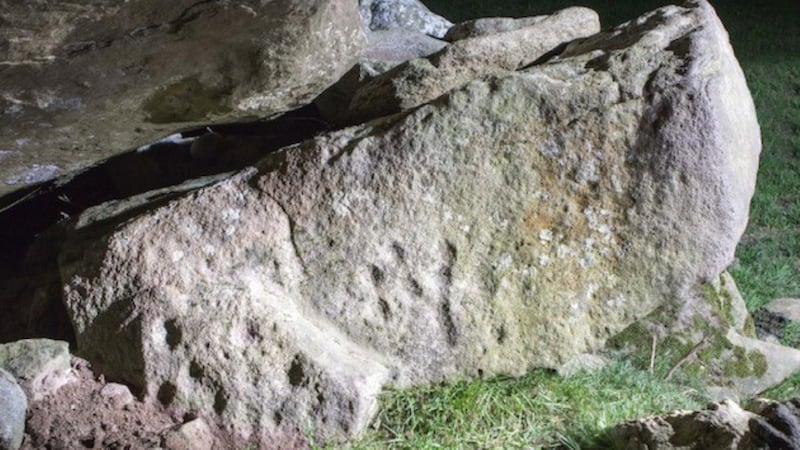Rare prehistoric rock art, believed to be at least 4,000 years old, has been discovered on a portal tomb in north Co Sligo.
It is one of a number of similar finds made in the course of a community project, which encourages “citizen archaeologists” to look out for and report artefacts.
Another highlight of the Sligo Community Archeology Project was the discovery during lockdown in March of a rare Bronze Age stone pendant in Drumcliffe. It was found by 14-year-old Darragh McDaniel while he was helping to dig a drain on his family’s land.

The prehistoric rock art was noticed at Cloghcor portal tomb by archeologist Tamlyn McHugh, who is heading up the community project, when she was conducting a video interview with the farmer who owns the land, Leo Leyden.
She later returned to the site after dark with her husband, Sligo-based landscape photographer Ciaran McHugh, and found that the rock art was more apparent in torch light.
The pair detected a series of cup marks incised into the surface of the stone, as well as a rosette design. Ms McHugh said that research was under way to determine if the rock art and the portal tomb are contemporaneous or if it was a later addition, “but it is prehistoric and at least 4,000 years old”. The find was reported to the National Monument Service (NMS).
Portal tombs
Christiaan Corlett, an archeologist with the NMS, described the discovery as “a very exciting find because rock art on portal tombs is rare”.
Portal tombs date to the Neolithic (4000BC-2500BC) age and are one of four types of megalithic tombs in Ireland, along with passage tombs, court tombs and wedge tombs. Ireland’s best-known portal tomb is Poulnabrone, in the Burren in Co Clare.
Ms McHugh said the community archaeology project, a joint initiative between Sligo County Council and the Heritage Council, was an opportunity to explore monuments like the Cloghcor portal tomb.
“It’s exciting that archaeological sites and artefacts are being found by the public – these significant discoveries can help us better understand our past and perhaps rewrite some of our interpretation of monuments,” said the archaeologist. The land owner, Mr Leyden, was also delighted with the discovery.
Farmers as custodians
“Farmers are custodians of these monuments and I am proud to have this tomb on the family land,” he said. “We have taken good care of the monument, observed it change through the seasons and have remembered the stories and legends associated with it down through the generations.”
Meanwhile, the Bronze Age pendant was not Darragh McDaniel’s only find. The teenager also discovered a Bronze Age “Fulacht Fia”, a burnt mound believed to have been an open-air cooking site.
In April, two previously unrecorded shell midden sites were found by local residents Eimear Healy and Daithi Bradley in Rosses Point and were added to the Archaeological Survey of Ireland. Last Friday two more middens were found at Mullaghmore. Middens are mounds of shells left by prehistoric people. Ms McHugh said numerous quern stones (tools for grinding grain) had also been found, including one which was brought ashore from Oyster Island by members of the North West Sea Kayaking Association.
These were reported to the National Museum of Ireland and have been deposited there. Nessa O’Connor, archaeologist and assistant keeper of Irish Antiquities at the National Museum of Ireland, emphasised the importance of reporting such objects.
“This could be your contribution to your own local heritage and help ensure that objects and related information on their context in the landscape can be available to all as a source of new archaeological knowledge and as a research resource.”








